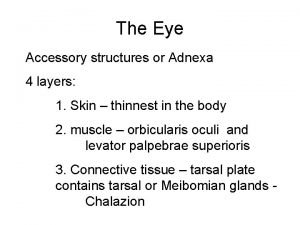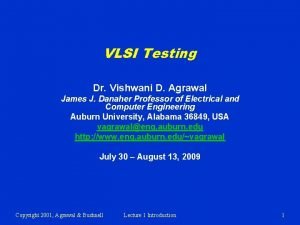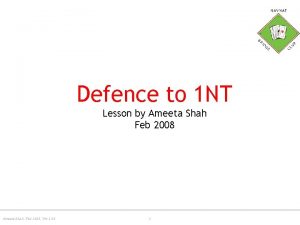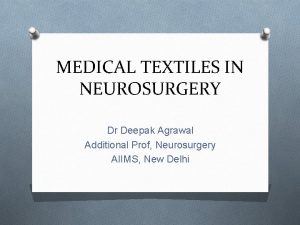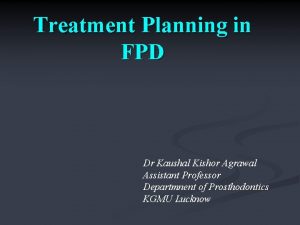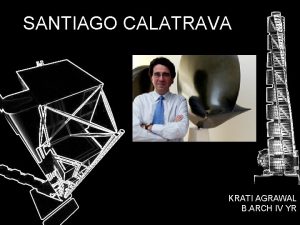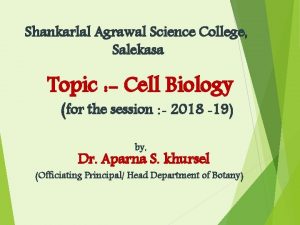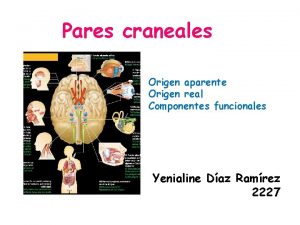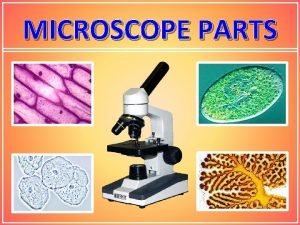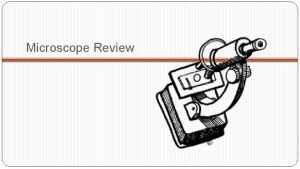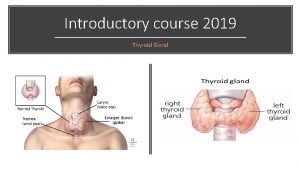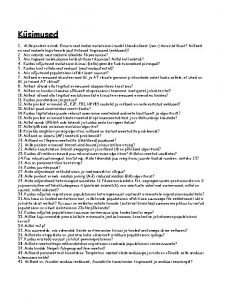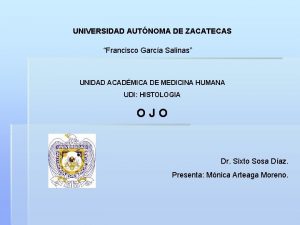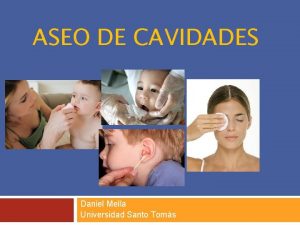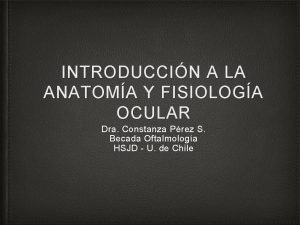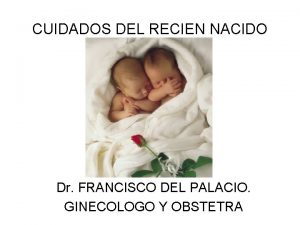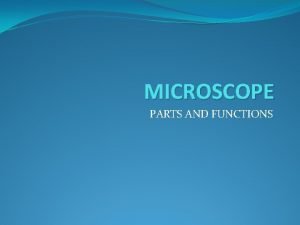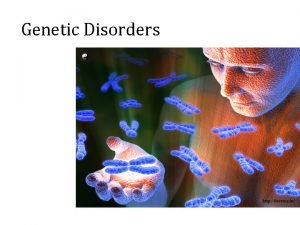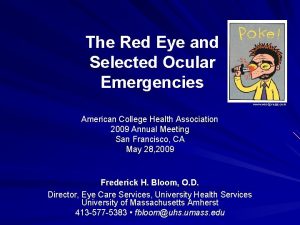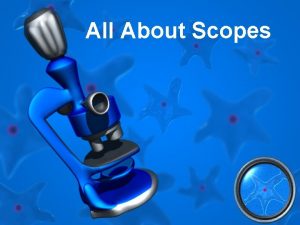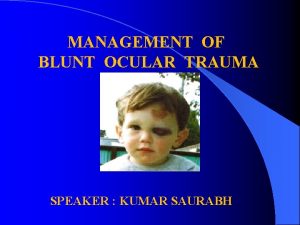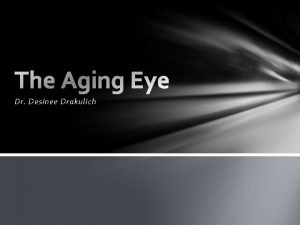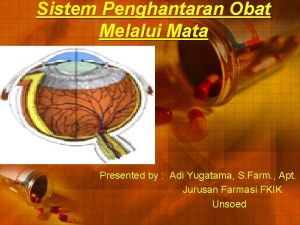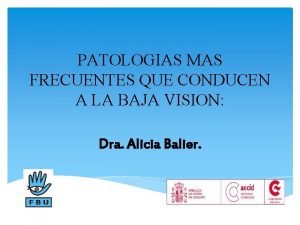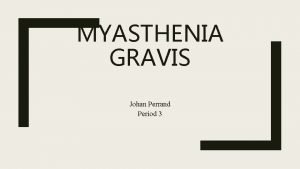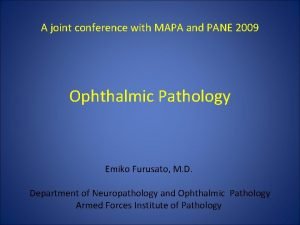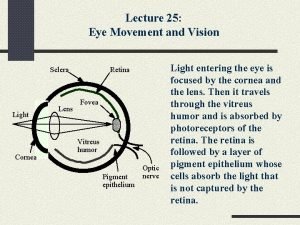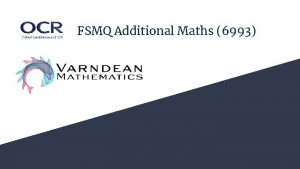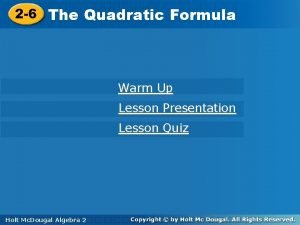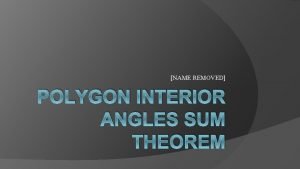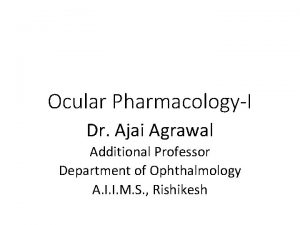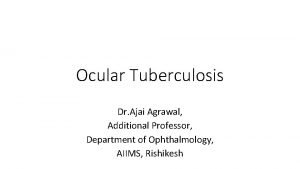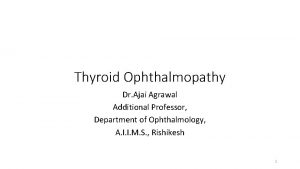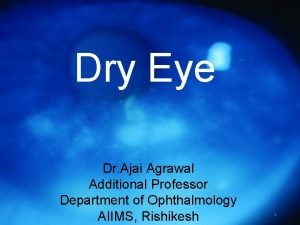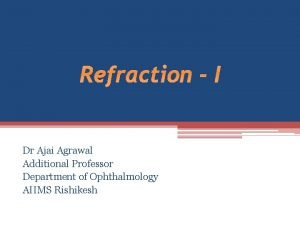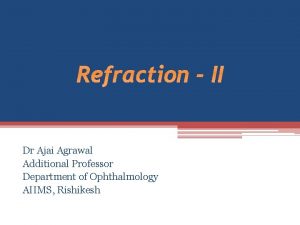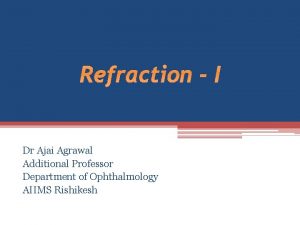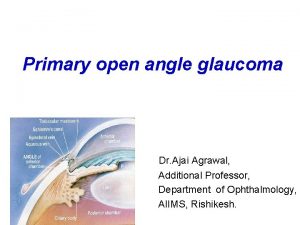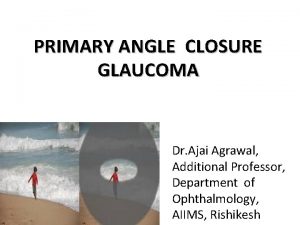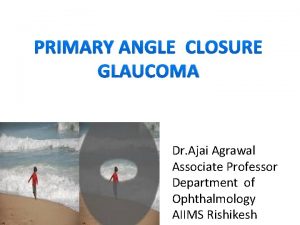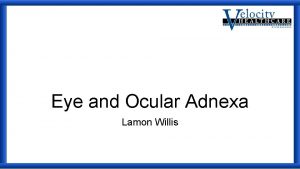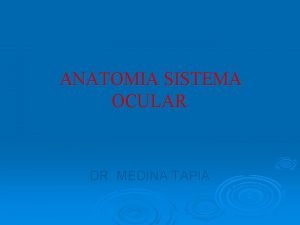Ocular Anatomy Dr Ajai Agrawal Additional Professor Department




















































- Slides: 52

Ocular Anatomy Dr. Ajai Agrawal Additional Professor Department of Ophthalmology A. I. I. M. S. , Rishikesh

Acknowledgement • Photographs included in the presentation are courtesy of Dr. Jonathan. J. Dutton and Dr. Thomas. G. Waldrop (Atlas of Clinical and Surgical Orbital Anatomy)

Learning Objectives At the end of this class students shall be able to • Identify various structures of the eye • Have a basic understanding of the structure and functions of various parts of the eye

• Orbit Lodges the eyeball • Eye lids – • Cover and protect • Lacrimal system. Secretes and drain tears • Extraocular musclesfor ocular movements • Layers of eyeballperform various functions

Bony Orbit • Made by 7 Bones: • Frontal • Zygomatic • Maxillary • Ethmoidal • Sphenoid • Lacrimal • Palatine

Frontal view of bony orbit

Outer eye: Eyelids The eyelids fulfill two main functions: • protection of the eyeball • secretion, distribution and drainage of tears

The eyelid muscles

Lid structure and movement ● The levator muscle extends from an attachment at the orbital apex to attachments at the tarsal plate and skin. ● The lids are securely attached at either end to the bony orbital margin by medial and lateral palpebral ligaments.

Innervation - Sensory innervation is from the trigeminal (fifth) cranial nerve, via the ophthalmic division (upper lid) and maxillary division (lower lid). - The orbicularis oculi is innervated by the facial (seventh) nerve. - The levator muscle in the upper lid is supplied by the oculomotor (third) nerve.

Blood supply Network of blood vessels which form an anastomosis between branches derived from the external carotid artery via the face and from the internal carotid artery via the orbit.

Lymphatics • Lymphatic fluid drains into the preauricular and submandibular nodes. • Preauricular lymphadenopathy is a useful sign of infective eyelid swelling (especially viral).

Lacrimal system • Lacrimal gland • Lacrimal passage • • Lacrimal puncta Lacrimal canaliculi Lacrimal sac Naso-lacrimal duct

Tear production • The lacrimal gland secretes most of the aqueous component of the tear film • Location: superotemporal part of the anterior orbit • Innervation : parasympathetic fibres carried by the facial nerve.

Lacrimal Apparatus/Drainage system

Extraocular muscles • 4 Recti • 2 Obliques Medial rectus (MR) Inferior Rectus (IR) Superior rectus (SR) Inferior oblique (IO) Superior Oblique(SO) Lateral Rectus (LR)



Extra-ocular muscles • Action results in eye movements • Medial Rectus --- Adduction • Inferior Rectus --Depression, Extorsion, Adduction • Superior Rectus --Elevation , Intorsion, Adduction • Inferior Oblique--Extorsion, Elevation, Abduction • Superior Oblique--Intorsion, Depression, Abduction • Lateral Rectus --- Abduction

EXTRAOCULAR MUSCLES

Nerve supply of Extra Ocular Muscles • Three Cranial Nerves supply the Extra Ocular Muscles • CN 3 rd-Oculomotor-MR, IR, SR, IO • CN 4 th-Trochlear—SO • CN 6 th- Abducens--- LR

Overview of ocular anatomy

Conjunctiva • The conjunctiva is a mucous membrane lining the eyelids. Covers the anterior eyeball up to the edge of the cornea. • At the upper and lower reflections between eyeball and eyelid, conjunctiva forms two sacs, the superior and inferior fornices.

Cornea and sclera The cornea and sclera form a spherical shell which makes up outer wall of eyeball.

Cornea and sclera • The sclera is : - principally collagenous, - avascular (apart from some vessels on its surface) - relatively acellular. It is perforated posteriorly by the optic nerve, and by sensory and motor nerves and blood vessels to the eyeball. The cornea and sclera merge at the corneal edge (the limbus).

Limbus • Juncture between the cornea and the sclera • Nourishes peripheral cornea • Assists in corneal wound healing • Pathway for aqueous outflow (contains trabecular meshwork and canal of schlemm)

Corneoscleral limbus • Transition zone: • anterior:bowman`s terminal-Descemet’s terminal • posterior:scleral spur/iris root • 1. 5~ 2. 0 mm width • Appearance • Semitransparant zone • White sclera • Angle of AC

The chief functions of the cornea • Protection against invasion of microorganisms into the eye • Transmission and focusing (refraction) of light.

Cornea • Made up of 5 layers • Specialized Transparent Tissue • No blood vessels • Primarily responsible for refracting light (43 -44 diopters) • More nerve endings than anywhere else in the body • Protection to the eye • The only part of the eye that is transplanted from one person to another

Cornea • Epithelium • Bowman membrane • Stroma • Descemet membrane (posterior limiting layer of cornea) • Endothelium

Cornea- 5 layered

Cornea • Oval • transverse: 11. 5~ 12 mm • vertical: 10. 5~ 11 mm • curvature:anterior: 7. 8 mm posterior: 6. 8 mm • thickness:centre: 0. 5~ 0. 55 mm periphery: 1 mm • Refractive index: 1. 377

Cornea 1. Epithelium : • 50μm • 5~ 6 layers • Squamous cell • Basal cell 2. Bowman’s membrane : • 12 μm • No cell • Collagen ,matrix • Renewing cycle≈7 days • Scar

Cornea 3. Stroma • 500 μm • 2~ 3% corneal cells • 1%matrix(GAGs) • Fibrous lamina 4. Descemet’s membrane – 10~ 12 μm – No structure – elasticity • 200~ 250 layers – Secreted by endothelial cells • Parallel to surface – Basal membrane of endothelial cell • Parallel collagen fibers • Ordered arrangement • Scar – Regeneration

Cornea 5. Endothelium : • 5 μm • Monolayer hexagon • 500 000 cells • Tight junctions • Pump

UVEA • The uvea comprises the • iris and ciliary body anteriorly • choroid posteriorly

Iris • Consists of connective tissue containing muscle fibres, blood vessels and pigment cells. Its posterior surface is lined by a layer of pigment cells. At its centre is an aperture, the pupil. The main function of pupil: Control light entry to the retina and to reduce intraocular light scatter.

Ciliary body • The ciliary body is a specialised structure uniting the iris with the choroid. • Secretes aqueous humour • Anchors the lens via the zonules, through which it modulates lens convexity. • The posterior part of the ciliary body merges into the retina at the ora serrata.

Choroid • The choroid, consisting of blood vessels, connective tissue and pigment cells, is sandwiched between the retina and the sclera. • It provides oxygen and nutrition to the outer retinal layers.

Lens • The discus-like lens comprises a mass of long cells known as fibres. Has a hard nucleus surrounded by less dense fibres, the cortex. • Relatively dehydrated • Transparent.

Aqueous humour • Fills the anterior and posterior chambers. • The anterior chamber is the space between the cornea and the iris. • Behind the iris and in front of the lens is the posterior chamber. They are connected by the pupil.

Formation • The ciliary body forms aqueous humour • By ultrafiltration and active secretion.

Drainage Aqueous circulates from the posterior to the anterior chamber through the pupil. Passes through the trabecular meshwork (a specialised tissue in the anterior chamber angle between the iris and the cornea). From here aqueous drains into Schlemm's canal.

Vitreous • A thick, transparent gel like substance that fills the center of eyeball, giving it form and shape • The vitreous body is 99% water but, vitally, also contains collagen fibrils and hyaluronan, which impart cohesion and a gel-like consistency. • The vitreous is adherent to the retina at certain points, particularly at the optic disc and at the ora serrata. • • Volume - 4. 5 ml RI: 1. 3360≈aqueous humor

Retina • Innermost layer of the eye. • Converts light energy electrical energy --->brain via the optic nerve • Composed of 10 layers. • Contains Photoreceptors • Cones-near Center (seeing detail and color) • Rods- in Periphery (seeing in low light and movement)

Retina • • • Transparent , thin Anterior rim:ora serrata 3 parts: Peripheral Retina Macula/fovea Optic disc

Retina • • Optic disc • Only optic nerve fibers • Physiological blind spot Macula • Thinnest • Point of sharpest vision is in the fovea located in the center of the macula

Histology of retina 1 RPE 2 Layers of Rods & Cones 3 External Limiting Membrane 4 Outer Nuclear layer 5 Outer Plexiform layer 6 Inner Nuclear layer 7 Inner Plexiform Layer 8 Ganglion Cell layer 9 Nerve Fibre layer 10 Internal limiting membrane

Retina • The blood supply of the retina is derived from the central retinal artery and vein, and from the choroid. • The retinal vessels enter and leave the eye through the optic nerve and run in the nerve fibre layer. A major arterial and venous branch, forming an 'arcade', supplies each of the retinal quadrants.

Optic nerve • The ganglion cell axons in the retinal nerve fibre layer make a rightangled turn into the optic nerve at the optic disc, which has no photoreceptors and corresponds to the physiological blind spot. • Behind the eyeball these axons become myelinated. • Here the optic nerve is surrounded by cerebrospinal fluid in an anterior extension of the subarachnoid space and is protected by the same membranous layers as the brain.

Optic Nerve Pathways/Visual Cortex • Message is carried down the optic nerve through pathways to occipital cortex; here vision becomes sight • At the optic chiasm, the nasal nerve fibers cross; temporal nerve fibers go straight back to cortex; this arrangement impacts on visual fields • Results in visual field losses can be predicted based on where damage is located on the optic nerve

Conclusion • The human eye is lodged inside bony orbit and protected by eyelids. • It has an outer protective scleral coat modified anteriorly to form cornea • The middle layer or uvea consists of the ciliary body and iris anteriorly and choroid posteriorly • The innermost layer is retina containing photoreceptors which lines the posterior two-thirds of choroid. • The optic nerve carries visual information to the visual cortex.
 Ajai nair
Ajai nair Eye accessory structures
Eye accessory structures Promotion from assistant to associate professor
Promotion from assistant to associate professor Anoop agrawal
Anoop agrawal Ca rakesh agrawal
Ca rakesh agrawal Shweta agarwal iit madras
Shweta agarwal iit madras Vishwani agrawal
Vishwani agrawal Asptro
Asptro Dr deepak agrawal
Dr deepak agrawal Dr kaushal agrawal
Dr kaushal agrawal Dr raj agrawal
Dr raj agrawal Nikolay yakovets
Nikolay yakovets Agrawal-kayal-saxena
Agrawal-kayal-saxena Krati agrawal
Krati agrawal Bio medical waste management introduction
Bio medical waste management introduction Shankarlal agrawal science college salekasa
Shankarlal agrawal science college salekasa Divyakant agrawal
Divyakant agrawal Subodh agrawal
Subodh agrawal V par craneal origen real y aparente
V par craneal origen real y aparente His salud ocular
His salud ocular Compound light microscope diaphragm
Compound light microscope diaphragm Body parts of microscope
Body parts of microscope Eye signs of thyrotoxicosis
Eye signs of thyrotoxicosis Ocular adnexa
Ocular adnexa Vestibulo ocular reflex
Vestibulo ocular reflex Allergic conjunctivitis icd 9
Allergic conjunctivitis icd 9 Epitelio conjuntiva ocular
Epitelio conjuntiva ocular Aseo de cavidad nasal
Aseo de cavidad nasal Globo ocular
Globo ocular Importancia de la profilaxis ocular del recién nacido
Importancia de la profilaxis ocular del recién nacido Coarse adjustment
Coarse adjustment Carlos algorra
Carlos algorra Ocular albinism
Ocular albinism Corneal abrasion treatment
Corneal abrasion treatment Brepharitis
Brepharitis Prime astaxanthin
Prime astaxanthin Ocular sign
Ocular sign Labeling a compound microscope
Labeling a compound microscope Ocular trauma score
Ocular trauma score Biometria ocular sod
Biometria ocular sod Decomposition
Decomposition Ocular drug delivery system
Ocular drug delivery system Candida uveitis
Candida uveitis Missed some points on the visual field test for dvla'
Missed some points on the visual field test for dvla' Vagabundeo ocular
Vagabundeo ocular What is myasthenia gravis
What is myasthenia gravis Bruch's membrane histology
Bruch's membrane histology Vestibulo ocular reflex
Vestibulo ocular reflex 10-5 secant lines and segments
10-5 secant lines and segments Fire watchers are additional personnel
Fire watchers are additional personnel Fsmq
Fsmq 2-6 additional practice the quadratic formula
2-6 additional practice the quadratic formula 6-1 additional practice the polygon angle-sum theorems
6-1 additional practice the polygon angle-sum theorems

